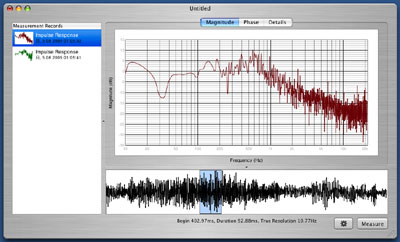

This has been consistent over several measurements. On this one we have focus on the 20 to 400 Hertz range, basically looking at modes below the critical frequency Fc of 244 Hz. Here are the results for the same room dimensions using the AMROC Room Mode Calculator. For this reason we have use the average width of 392 centimetre to calculate the room modes.

As mentioned before the room has two different widths and therefore would require more complex calculation. One of the challenges faced with the room we chose is the irregular shape. Room mode can be calculated using various Internet Site calculators and the Spread Sheet made by Guy Cooper. Room mode calculations allow us to understand some of the causes of room frequency response peaks and dips. However, compare with the REW results above, the long decay below 80 Hertz does not appear to be as prominent. We can also observe almost the same peak and dip in the low frequencies dip just above 100 Hertz and peak in the 200 to 300 Hertz area. We can observe more or less a similar response graph as with REW. The following two pictures show the Sine Wave Sweep made using the Left and Right speakers with the reference microphone above the engineers seat.
#Fuzzmeasure alternative software
REW includes a level check function with ensure the test is being made within the software allowed range.
#Fuzzmeasure alternative full
However, with the sine wave sweep, REW can extract the slop angles under reduce range and extrapolate the full RT60 time.

This level may not be sufficient for accurate RT60 measurements from an impulse as it need a 60 dB drop. Several tests were made to ensure the level was sufficient, above 75 dB. I have also calibrated the microphone in REW so the reported graphs are reasonably accurate, or at least with in the range of level indicated. All sine wave sweep tests were ran with both the window and the door close to reproduce most likely listening and recording conditions. Once again, the reference microphone was placed at the current listening position, few centimetres above the engineer’s head. Guy Cooper Excel spreadsheet calculatorĪfter these attempts of recording impulse response, I have redirected my efforts toward the use of the room analysis software, running sweep signal response tests.The different software use for the tests:Īdditional On-Line and calculation tools: A low cost sound level meter was use to measure noise level and to calibrate the measurement software application. Also most tests were conducted whit he engineer standing outside of the room. All tests were ran with both the window and the door close to reproduce most likely listening and recording conditions. As mentioned before, this is the exact centre of the room in length and height. The reference microphone was always place at the set listening position, few centimetres above the engineer’s head.
#Fuzzmeasure alternative pro
But his will the position we will refer to in this blog.Īccording to Bolt, this is not a good room.Īll the recordings and measurements were made using a DBX Pro RTA-M reference microphone with a Shure Xu2 XLR-to-USB Interface connected to a MacBook Pro laptop. Currently, this brought the listening position to the centre of the room, which is not recommended. The current speakers and desk setup is base on preliminary readings recommending an equal distance between the speakers and the engineer’s head. The furniture and equipment layout is still embryonic and may change in the future. A desk made of a Stratocaster and speaker cases,.Another large bookshelf can be seen on the right wall,.Two 2 large bookshelves fill the back wall, the remaining space is the door.Most of the room content appears on the pictures. Most of the wall and ceiling are still bare. There is only a small window on the front wall, 180 cm wide by 60 cm high.


 0 kommentar(er)
0 kommentar(er)
